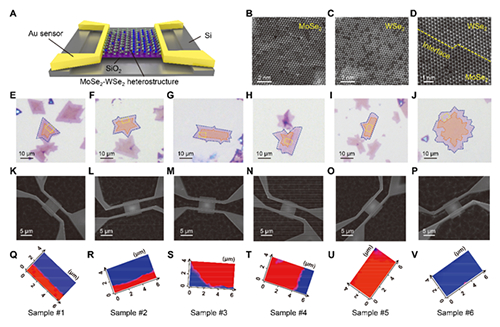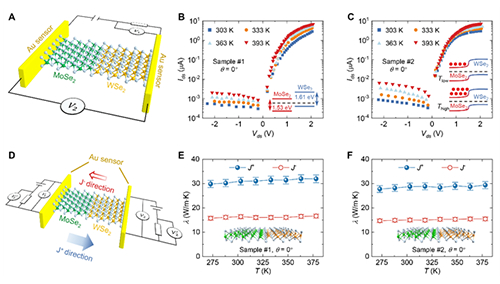Supported by the National Natural Science Foundation of China (Grant No. 51976096, 51827807, 52130602), Prof. Xing Zhang and Associate Prof. Haidong Wang’s research group from the School of Aerospace Engineering, Associate Prof. Ruitao Lv’s research group from the School of Materials Science and Engineering at Tsinghua University cooperated to develop the first two-dimensional (2D) lateral heterogeneous integrated electrical and thermal rectifier. The rectifier achieves a high electrical ON/OFF ratio up to 104 and a thermal rectification factor as high as 96% in the atomically thin monolayer heterojunction. The related research was titled "Simultaneous electrical and thermal rectification in a monolayer lateral heterojunction" and published in Science recently.
Article link: http://www.science.org/doi/10.1126/science.abq0883.
Chip manufacturing is a stranglehold problem of our country. With the decreasing trend of chip size, materials science and thermal science fields have been faced with new challenges. On the one hand, the gate width of traditional silicon-based transistors is approaching its physical limit. Thus, it is necessary to find the next generation of semiconductor materials to further improve the integration of chips. Due to their atomic thickness and extremely high ON/OFF ratio, transition metal dichalcogenide (TMDCs) monolayers are expected to replace silicon-based materials to ulteriorly minimize the size of transistors. On the other hand, high integration of chips will inevitably lead to a dramatic increase in the heat flux density, which makes the heat dissipation problem a key challenge hindering the development of the chip industry. Generally, owing to Umklapp phonon-phonon scattering commonly found in semiconductor materials, the thermal conductivity of material will decrease as the temperature rises, which accelerates the thermal failure of electronic devices under high-power density operating conditions.
In order to solve above problems, the research group used the atmospheric-pressure chemical vapor deposition (AP-CVD) method to synthesize single-layer MoSe2-WSe2 lateral heterojunction materials and fabricated suspended H-type electronic devices with different heterojunction interface angles by high-precision nano-positioning and electron beam lithography technology (Fig.1). The measurement results show that the device has the maximum electrical ON/OFF ratio of 104 and thermal rectification ratio of 96% when electrons and phonons pass vertically through the heterojunction interface (Fig.2). Furthermore, the research group found that the thermal rectification effect will significantly improve the heat dissipation ability of electronic devices under the high power conditions. When the diode device is in the forward conduction state, the current through the device increases rapidly with the increase of power, and an obvious temperature gradient will be formed from MoSe2 to WSe2 direction, which increases the thermal conductivity in this direction by 96%. The increase in the thermal conductivity of the material will tremendously improve the heat dissipation performance of the device. Besides, the experimental results demonstrate that the monolayer 2D heterojunction rectifier device can withstand a large bias voltage of 60 V, and the local temperature rise of the device is about 20 % lower than that without thermal rectification.

Fig. 1. Fabrication and characterization of MoSe2-WSe2 lateral heterojunction rectifying devices with different interface angles

Fig. 2. Measurement results of electrical and thermal rectification characteristics of MoSe2-WSe2 lateral heterojunction device.
This study shows that the novel 2D lateral heterojunction device not only has the advantages of atomic thickness, wide bandgap, and high mobility, but also can significantly improve the thermal conductivity of the device along a specific direction under the high-power operating conditions. In addition, local high temperature and thermal stress can be greatly reduced without external cooling, effectively improving device performance and extending its service life. The research results are expected to change the traditional idea of cooling chips only by external means, and fundamentally solve the heat dissipation problem of high-power chips by improving the thermal conductivity of semiconductor material itself.

Add: 83 Shuangqing Rd., Haidian District, Beijing, China
Postcode: 100085
Tel: 86-10-62327001
Fax: 86-10-62327004
E-mail: bic@donnasnhdiary.org
京ICP备05002826号 文保网安备1101080035号 Copyright 2017 NSFC, All Right Reserved